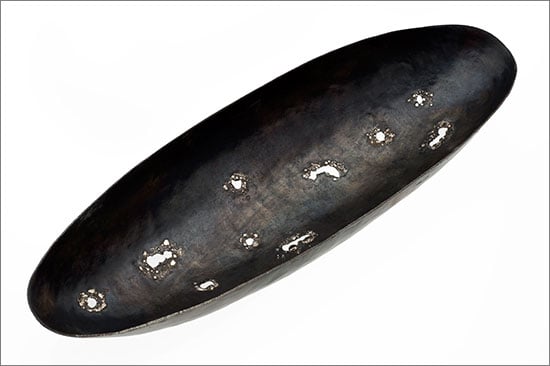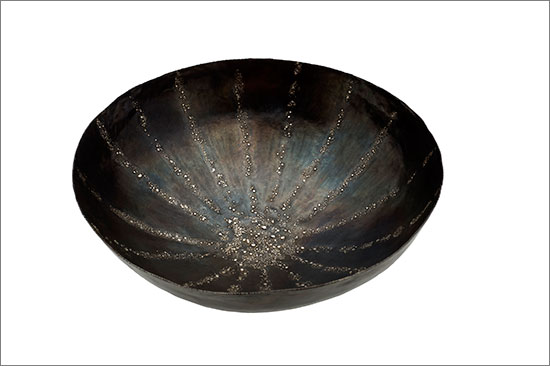Materials: Steel, Fine Silver
Dimensions: 6" x 6" x 4"
These bowls are formed in a very direct manner, a sort of free form die forming into hot steel. The bowls are then fused with fine silver, oxidized, planished, and polished. Once finished, the bowls are very resnant and when held gently and struck, they produce a long lasting tone. The combined effect of the curvature of the inside of the bowl, the organic patterning and radiance of the silver, and the strong vibration of the bowl is meant to remind the user of meditation under a wide night sky.
Photo credit: ETC Photography
Jak Martin
Jake Martin Jewelry
Rochester, NY. USA
We are products of the Earth, rising from the waters and reaching for the cosmos. The Earth is coalesced from the very essence of creation, and through an eternal evolutionary process, we, ourselves and everything around us, connect to a single, harmonious, unifying point of creation. That creative force exists in us as we are born of it, and resides deep in the center of heart and mind.
When observed, nature seems to follow certain codes and structures, often revealed as natural laws and basic blue-prints for forms of life. What we deem geometry and physics (and indeed all of the sciences) are revelations of that very essence of creation, and by recognizing them and utilizing them in our own personal creations, we are connecting and unifying with that creative force. Harmonizing with the tones of the song of creation.
Reality exists on vast regions of scale, most unattainabale to us at most times. The structures and building blocks of the inhabitants of these realms of extreme scale are analogous to those at our own. To notice these similarities is to notice something boldly unifying in our existence, just as shamans, scientists, and artists throughout time. To use these principals in creation of objects is not only to participate in a long history of tradition but also is to create using similar principals and guidelines as the creative force of our universe. The intention to relate universal commonalities in form to a human scale informed the choice of creating work that is either meant to be worn, an intimate means of relating to self, or work that interacts with ones environment, a less intimate but more visceral and accessible means of relating to self.
My working process is ritualistic and informed by thousands of years of tradition. The process is a form of active meditation. When in the feedback loop of designing/making, I am able to briefly disconnect from a separate, dichotomous, individual self and connect with a vaster awareness. My major medium, jewelry, has embodied the essence of divinity from the time of the mediums origin and serves as a reminder of majesty and beauty. My designs come from observing nature, not by segregating certain aspects, but from recognizing the common structures. The work serves to connect maker, wearer, and observer in a harmonious way with each other and to serve as a reminder of the divinity of ourselves and of all things.
These containers and vessels definitely hold their place in the world of stunning art objects as well as in the world of metalsmithing.
Since the dawn of time humans have created containers to hold things that were important to them, from large vessels to hold food and harvests to intimate containers for small precious things. They might hold memories, ashes, medicine, beverage, fruit or food - but all spring from the imagination and skill of the maker. Some have specific religious functions, some are meant for everyday use. When one thinks of a vessel or container the inclination is to think of something with solid walls - yet many of these works involve the exploration of positive and negative space, and the use of negative space to help create the illusion of the wall of the vessel.
As the world’s largest jewelry related internet site, Ganoksin strives to develop exhibitions showcasing work from around the world. This exhibition was open to all metalsmiths, professional and amateur, advanced and beginner. Participants are from The Netherlands, the USA, Canada, Australia, Costa Rica, the United Kingdom, Israel, Hong Kong, Colombia, Romania, Italy, Ireland, Japan, Malaysia and Denmark. While most of the pieces are by an individual metalsmith, some are collaborations, one of three artists spanning 50 years.
In total 319 artists contributed 729 show pieces for the permanent online exhibition.
Objects in the exhibition include boxes, lockets, urns, ash containers, bowls, wine cups, reliquaries, match holders, vases, teapots, pitchers, sugar bowls, baskets, nests, pillboxes, clutches and a range of sculptural forms. A variety of techniques are showcased covering a wide range of metalsmithing techniques. Materials used include everything from gold and silver to less expensive metals. Ornamentation includes the addition of enamel, chasing and repousse’, gemstones and found objects.
The exhibition was curated by Beth Wicker, President of the North Carolina Society of Goldsmiths in the United States, and Adjunct Instructor at Northeastern Technical College in South Carolina. Director of the exhibition is Hanuman Aspler, founder of The Ganoksin Project, the world’s largest internet jewelry site.
http://www.ganoksin.com/exhibition/var/albums/HoldingPlace2013/4770_Martin_10.jpg

